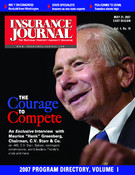Private mortgage insurance is making a comeback.
Until six or eight months ago, private mortgage insurance was out of favor as people eager to get into the roaring housing market took adjustable-rate mortgages or “piggyback” loans or some other exotic form of financing.
But as the market has cooled and lenders have tightened their standards, many people who want homes — especially first-time home buyers and those with little money for down payments — are choosing traditional fixed-rate mortgages backed by private mortgage insurance, or PMI.
The insurance costs the borrower a monthly fee, typically a set percentage of the total mortgage loan. If for some reason the borrower can’t repay the loan, the insurance kicks in and the lender gets some of its money back. Because of the guarantee, lenders are more willing to write the mortgages.
Pat Lamb, president of the mortgage division of First National Bank of Arizona in Scottsdale, said that until about six months ago, most home buyers who didn’t have the money for a 20 percent down payment were opting for piggyback loans.
These loans actually involve two mortgages. In an 80-10-10 configuration, the home buyers puts 10 percent of the home’s value down in cash, gets a primary mortgage for 80 percent and then takes a second mortgage for 10 percent. The advantage of this approach is that the interest on both mortgages can be written off at tax time; the disadvantage is that the rate on the second mortgage generally is at least 2 percentage points higher than on the first and can rise with market rates.
“In last six months, the mortgage insurance side has become much more competitive,” Lamb said. This is due, in part, to lenders becoming more hesitant to make piggyback loans because of problems selling them to investors, he said. Rising defaults in subprime mortgages, which are aimed at people with poor credit, had made investors shy away from second mortgages, Lamb said. But these same investors are comforted when loans are backed with mortgage insurance, he said.
Data from the mortgage insurers’ trade association, the Mortgage Insurance Companies of America in Washington, D.C., shows that even as housing sales have dropped, the use of PMI has risen.
The group said that 118,214 borrowers used PMI to buy or refinance a home in February, up from 104,146 a year earlier. The dollar volume of insurance written increased to nearly $17 billion in February from $15.2 billion a year earlier.
David H. Katkov, president of PMI Mortgage Insurance Co., a division of the PMI Group, said the swing back to the use of PMI grows not only out of weakness in the subprime market but also a sense in the industry that “some of the exotic mortgage types were inappropriate for many buyers” and that conventional mortgages with PMI made more sense.
Another incentive is that PMI premiums are tax deductible for mortgages closed in 2007.
Was this article valuable?
Here are more articles you may enjoy.


 Trump’s Bond Insurer Tells Judge Shortfall Is ‘Inconceivable’
Trump’s Bond Insurer Tells Judge Shortfall Is ‘Inconceivable’  JPMorgan Client Who Lost $50 Million Fortune Faces Court Setback
JPMorgan Client Who Lost $50 Million Fortune Faces Court Setback  Why New York’s Attorney General Objects to Trump’s Bond Insurer
Why New York’s Attorney General Objects to Trump’s Bond Insurer  Jury Awards $80M to 3 Former Zurich NA Employees for Wrongful Termination
Jury Awards $80M to 3 Former Zurich NA Employees for Wrongful Termination 


